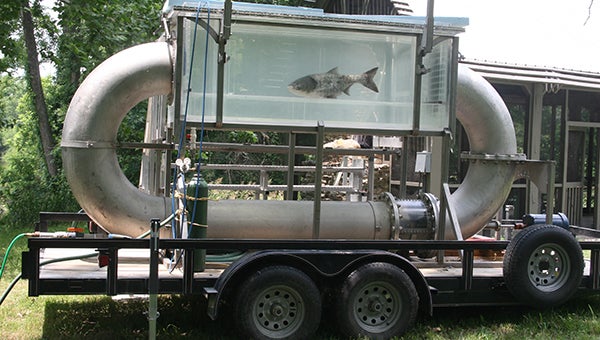ERDC scientists seek ways to control invasive carp
Published 9:16 pm Saturday, May 7, 2016

- INVASIVE FISH: A silver carp swims against the current in the mobile swim tank developed at ERDC to test the fish’s ability to swim against a certain current velocity. Photo courtesy ERDC 050816carpJCS Aquatic lab technician Bradley Lewis examines a slide of a pectoral fin ray from a silver carp. Scientists determine the age of the fish by counting the rings in the fin ray. John Surratt 050816carpJCS2 Research fisheries biologist Dr. Jan Jefferey Hoover explains a chart showing velocity rates and how they can keep carp contained. John Surratt 050816carpJCS3 Research fisheries biologist Dr. Jan Jefferey Hoover shows the two tubes used in the mobile swim tank to test a carp’s swimming ability against a current, John Surratt
Google “silver carp,” and there are 2.86 million references to the large, silver fish that has a reputation for flying out of the water and into boats.
Go on YouTube, and there are 36,300 related videos about the fish, showing its prowess at leaping, describing its threat to native game fish like bass and offering a tutorial how to cook them.
Better known by the scientists who study it as the Asian carp, the silver carp is an invasive species — an animal, insect, plant, bacteria or other organism that is not native to the environment where it lives and can harm surrounding eco-systems.
It is one of three species of Asian carp in the United States — the other two are the Bighead carp, and the grass carp, which was imported to the U.S. to control vegetation in ponds.
All three carp are invasive, but the silver carp, which entered the Mississippi River almost 30 years ago, is the problem fish because of its ability to reproduce and threaten native species of fresh water plankton-eating fish like paddlefish and crappie.
“It was brought in during the late 1970s to some facilities in Arkansas, and they’re believed to have escaped during the early 1980s during flooding,” said research fishery biologist Dr. Jan Jefferey Hoover with the U.S. Army Engineering Research and Development Center in Vicksburg. “The carp were brought in as a form of biologic control for nuisance plankton or algal growth; to clean up sewage ponds.”
He said ERDC scientists saw their first silver carp in the area around Vicksburg in 1989 or 1990, when specimens began showing up in the Mississippi Delta where the bulk of the ERDC fish research was being done.
“Right now, they’re present in the lower and middle Mississippi River and dense in the Illinois River,” Hoover said. “They’re all over the basin, but they haven’t gotten into the Great Lakes and they’ve made only limited headway into the upper Mississippi River.”
Lake Albemarle and Lake Chotard, two oxbow lakes in northern Warren County, “are infested with them,” added research fisheries biologist Dr. Jack Killgore. In 2012, he said, carp were found in the Pearl River. More recently, state Wildlife Fisheries & Parks officials were concerned about the potential of silver carp invading Eagle Lake as the Corps’ Vicksburg District opened the Muddy Bayou Control Structure to reduce the level of the lake by about 4 feet.
And finding ways to either contain the carp or flush the fish out of areas where they’ve congregated is the goal for Hoover and Killgore.
“We’ve been working with carp for over 10 years, and we study all aspects of carp biology, we are sponsored by the Aquatic Nuisance Species Research Program.” Hoover said. “We specialize in areas that other people have not done. I don’t know any other lab that’s done much in the way of swim studies.
“We study all aspects, we study their population biology, we study their swimming capabilities and their impacts on native species.”
Most of the work at ERDC’s Aquatic & Wetlands Ecosystems Research and Development Center, Killgore said, involves developing an electrical containment barrier to keep the carp from getting into the Great Lakes. Electrical containment, he said, is being used in the Chicago Area Waterway System.
Hoover is working on another process called hydraulic containment — regulating the force of the water flow, or current, to contain the carp or force them away from certain areas. This technique is being considered for the Upper Mississippi River, the Ohio River and other waterways.
“With carp, we’re trying to establish what velocities they can’t swim against, and use those as a hydraulic barrier; a way of containing them in certain areas,” he said, adding one reason the carp haven’t made the headway in the Upper Mississippi as they have in the rest of the river is the system of 27 locks and dams along the Upper Mississippi.
“They’re a physical obstruction, partially blocking the route, and there’s flow through the gates, so that’s already dissuading them from going up stream,” he said, “So they’re already functioning as hydraulic barriers. We believe it’s possible by refining the operations of those locks and dams to keep any of them from going through.”
But determining the right flow and velocity to contain the carp requires testing.
“You need to know what speeds they swim and how long they’re capable of maintaining those speeds,” Hoover said, adding initial swim studies were done in the laboratory.
Tests to determine the correct flow to contain the carp are now done in a mobile swim tunnel developed at ERDC to determine how long a carp can swim against the water flowing at different velocities.
“This is a one-of-a kind device,” Hoover said, “It was designed and built here at ERDC and it is the largest of its type.”
The tunnel is towed into the field where biologists are working and then filled with water. When a carp is caught, it is taken directly to the tunnel and put in the tank to see how long it can swim at a particular speed.
“It’s less than a 5-minute trip (from the water to the tank) so the fish doesn’t get stressed out and we drop it in the tunnel,” Hoover said. “The motor (for the propeller) is behind the tank, but the prop built in the (water) tube. It circulates the water in an elliptical pattern for better flow.”
The tunnel, he said, has been in demand. He said ERDC biologists have used the tunnel in partnership with the University of Georgia on a sturgeon study, with the University of Mississippi on a paddlefish study, and for the University of Minnesota, to determine the flow rates to keep carp from entering streams there.
But hydraulic flow and electrical containment only addresses containing carp in areas where they haven’t already established themselves. Another problem is how to deal with areas where the carp have become established.
“It’s one thing to keep them out, but it’s another thing to get rid of them, and that’s a fairly contentious issue, Hoover said.
One suggestion is harvesting the carp as a food source.
“It would take (harvesting) 50 to 70 percent of the (carp) population to even get numbers down,” Hoover said, “and that model’s based on assumption that the fish do not reach a certain size, and do not reach a certain age. “What we’re finding is they’re living longer than we thought and they’re reaching sizes we never thought. The reason that size is a factor, is the number of eggs a female lays is disproportionate to her size, so if fish are getting a little bit bigger, they’re laying a lot more eggs, and there’s a lot more work to be done. The models for harvest need to be re-addressed.”
Another problem is the price commercial fishermen are paid for carp, Killgore said.
“That’s the problem now, why should a commercial fisherman go after something that’s 10 cents a pound when he can catch buffalo (suckers) for 30 cents a pound,” he said.
The carp, however, are being actively caught.
“The Chinese have brought their own fishing crews over, and they’re out there constantly catching big head and Asian silver carp and fileting them and flash-freezing them and shipping over to China,” Killgore said. “There are discussions of new plant in Kentucky (by an American company), a riverine fisheries that catches and processes the carp. They brought in a factory boat from Alaska. Jack there’s more of a market for them in China.”
“There’s kind of a stigma about eating carp in the United States,” Hoover said. “There was a research effort on preparing and marketing carp. Calling the fish silver fin, because silver fin sounds better than silver carp.”
An indicator of how important the fish is outside the U.S., he said, came during a tour of the river by Chinese visitors that included displays of freshly caught American aquatic life.
“What they got excited about was when we brought out the Asian carp,” he said. “Their stocks are overfished. They have the opposite problem we have. We have too many Asian carp; they don’t have enough.”
And while the carp are having an adverse effect on native game fish in the area, the potential effect on Eagle Lake is unknown.
“If they get into Eagle Lake, then it’s kind of a waiting game,” Hoover said. “They’re not going to reproduce in the lake. We have some evidence that they may have reproduced in one Mississippi lake, but they just don’t normally reproduce (in lakes). They may release the eggs, but they don’t have spawning habitat, so you could see the numbers decline over time. Their eggs sink and they’re sticky, and they need to stick to gravel and packed sand; they have to have flowing water.”
Also, Kilgore said, flowing water keeps the eggs suspended, too, where they don’t sink into the sediment where they’ll smother. It’s also possible that some carp leave the lake when the Muddy Bayou chute is open and head for flowing water to breed.
And why do they jump? There are several theories, the most popular of which is they are affected by outboard motors.
But Hoover said he has seen the same behavior when a net is drug through the water.
“It’s not the same noise as a motor, but you get a pressure wake like you do with a boat and you get a vibration as the net is moving through the water, so there’s some kind of vibratory or auditory stimulus that makes them do that.”
Hoover said a University of Mississippi graduate student working with ERDC believes the jumping is a way to escape predators, “because in the Yangtze, there are some very large fish and alligators that can eat them, so they may have evolved that behavior as a kind of evasion. The bighead carp typically are bigger, so they can escape predators buy simply being a bit larger.”
Hoover said scientists think the very large silver carp also don’t jump.
“We’re beginning to keep track of how big fish are when they land in a boat, and it seems when they get to a certain size like 700 millimeter size (about 2.2 feet), we’re not seeing them land in the boat any more. Once they reach a certain size, they’re not so aerodynamic, but they’re also of a certain size that something’s less likely to eat them.
“Small size school; larger fish, jump; and extra large fish are safe,” he said.






